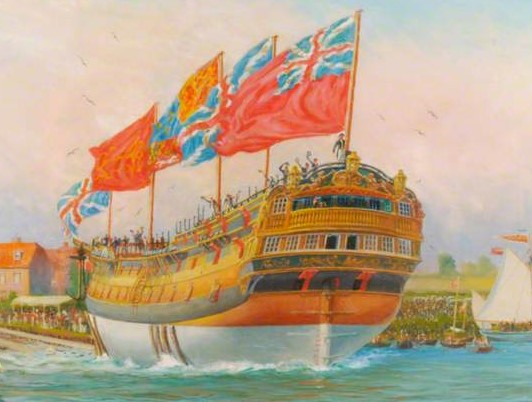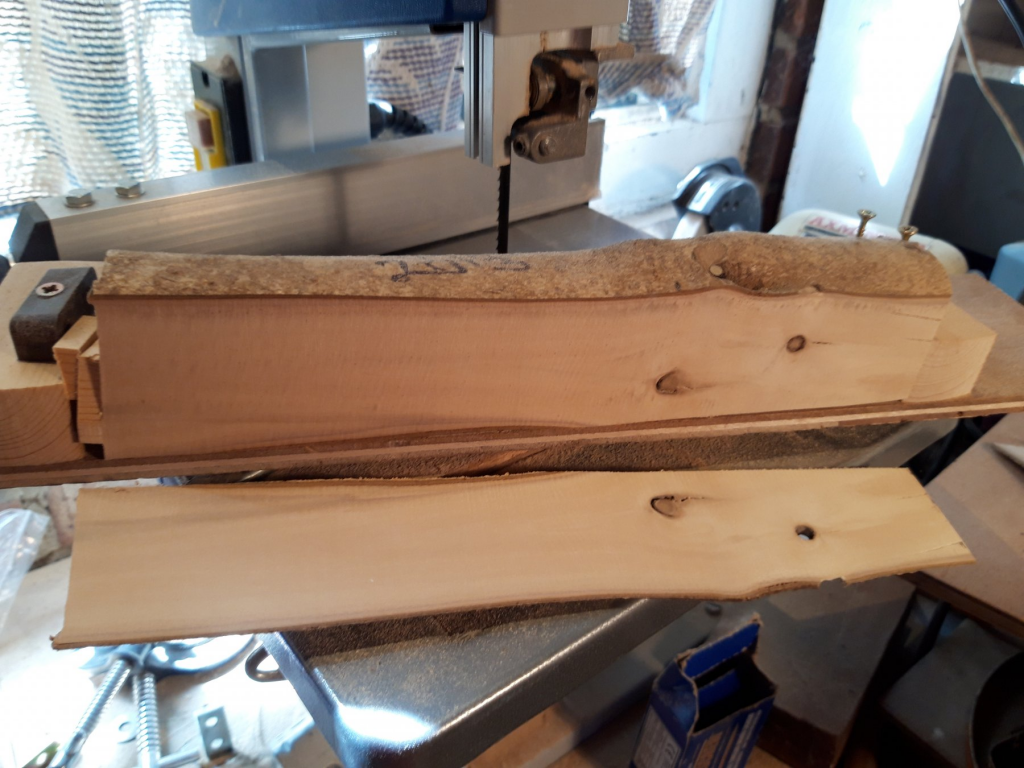-
Posts
3,034 -
Joined
-
Last visited
Content Type
Profiles
Forums
Gallery
Events
Everything posted by bruce d
-
Trust is hard to come by in research. I hope that my prodding of the subject is welcomed, but feel free to say if you have already covered all sources. Until recently, I earned my crust as a researcher. Now I have retired it is difficult to break old habits so I dug a bit. Have you asked the NMM about the contents of folio ADUB0340? The description of this folio is sparse but includes a misspelling of the ship's name and may not have come up in routine searches. With no dates, it may or may not be your Agamemnon. As the only other class ship produced at Bucklers Yard was Agamemnon, I see why the Indefatigable plans are such an appealing prospect. Bruce
-
It was about the time that the powers-that-be started to get serious about standardization and, who knows, it may have reached the subject of framing/windows? The Pocock painting in post #289 above has some merit as a source: it was a contemporary work by an artist who was famed for doing research on his subject. He may have 'blinged up' some aspects but there was no profit in changing such details as windows. If he included eight windows he probably did not think the ship had seven. Has anyone looked at the logs of the ship? Details crop up, especially around the time work in a dockyard happens. HTH Bruce
-
Yank? Things have changed since my last visit to Oklahoma.
- 19 replies
-
- hermione
- artesania latina
-
(and 1 more)
Tagged with:
-
'Splicing the Mainbrace' is sailor-speak for 'have a drink'. Good looking model. Regards, Bruce
- 19 replies
-
- hermione
- artesania latina
-
(and 1 more)
Tagged with:
-
Hello Steve Welcome to MSW. It is a great place.
-
Jaager, I have had good results from the holly I have cut so far. I sealed the ends soon after cutting and because the tree came down in winter (so I have been told) the odds are better. I think the blue mould is less of a problem over here but it definately can happen. The deck is the area where I want to stick close to the pale white holly colour so, if some of it shows discolouration, I will use the best for the deck and the duff stuff for the hull planking which will be painted/stained and coppered. I have about six of lengths as in the photo which is enough for my modelling needs, I expect, and more wood is seasoning from a cull last year. It is beautiful wood. Bruce
-
I am cheating. The holly is from my garden, brought down by high winds in December 2013 and stashed in anticipation of this project. The first layer will be something else, perhaps beech or Sapele, both are available. Actually, I suppose that since I have a free hand the priority should be something easy to shape and sand for the first layer. Now that I have seen the responses I have started adjusting the frame drawings to allow for the two layers. Thanks Mike. Bruce
-
Many thanks, Kurt. I am glad MSW is here for pooling iinformation. Before cutting a single piece of wood for my retirement project ship-build I have had the benefit of advice from experienced builders. Having spent time researching and drawing, digging and digesting, it is good to know that I have served a 'mini-apprenticeship' and enjoyed doing it.
-
OK, this helped. ... and ... Jason, I will do a double planked hull. This was my Plan A but I needed to be told that I wasn't missing a trick. Kurt, your comment on spacing was a bulls-eye because this was what alerted me that I was 'out of step' with other builds: my schooner will have plenty of bulkheads and the great majority of builds I had looked at with similar construction were single planked. Many thanks for the input. You may even see a build log before long! Bruce
-
Hello Gregory Yes, and maybe I am assuming too much but I imagine some experienced builders have clear opinions on the subject. I suppose it is yet another sign of hesitancy on my part, I know there is no rule to break or planking police to enforce it, but I have drawn my plans and after a year of anticipation this one point can still be adjusted. I am concious of being an inexperienced builder and wonder if one technique is more forgiving than the other, or one is more suited to the subject (P.O.B. schooner at 1/40th)? There is a whole bunch of unanswered questions that I am looking forward to tackling myself as the build progresses but this seemed like the best time to sort out this particular point. Thanks, Bruce
-
I hope the forum will provide some last minute advice. I am about ready to start cutting wood for my first wooden ship scratchbuild, a P.O.B. schooner in 1/40 scale. This will be my first attempt at planking a hull. I have read logs and how-to guides looking for a clear statement (and reason) from a modern source on why one or the other technique would be best for a particular project. No luck. If it sways opinion one way or another, the finished hull will be painted and coppered. The planks (outermost if double planked) will be holly. Any comments? Thanks in advance. Bruce
-
Hello Christian, I have sat down in the shade to catch up with your build. It is superb. Stay out of the sun! Regards, Bruce
- 550 replies
-
- confederacy
- model shipways
-
(and 1 more)
Tagged with:
-
It is probably worth getting in touch with these guys: http://www.exotichardwoods.co.uk/ They trade under the name 'Timberline' and have a lot of different woods, mainly serving the musical instrument makers of this island. I have found them to be very helpful. You may be offered sheets/strips of another width but it is a start. HTH Bruce
-

‘Eighteenth Century Rigs & Rigging’ by Marquardt
bruce d replied to bruce d's topic in Masting, rigging and sails
Thanks Allan, gott'em. They are great and I think this book completes the story. I have been going through some sections this afternoon and am pleased to see that most of the masts/spars I have drawn so far conform, I will have to decide what to leave and what to re-think. I promised myself I would not buy books on impulse. I am trying, but it is so hard .... Bruce -

‘Eighteenth Century Rigs & Rigging’ by Marquardt
bruce d replied to bruce d's topic in Masting, rigging and sails
I got the book. As soon as I looked at the content and format it became clear this is a summary of scantlings of the era with plain language explanations to guide the modeller. I am very glad I made the trip to the shop with the book, even though I have PDFs of some of the scantlings from that time-frame. This is what I needed: a modeller explaining the subject for the benefit of other modellers. Thanks for the help. Bruce -

‘Eighteenth Century Rigs & Rigging’ by Marquardt
bruce d replied to bruce d's topic in Masting, rigging and sails
Jan, I think I am going to get the book. Thank you for the advice, I believe 'quite a lot of ship types' is what I need. When I narrow it down I can look for more detail of a particular type/rig. There is so much to learn! Bruce -
Hello Nils, perhaps you can find some help here: www.oldmarineengine.com/ Keep up the good work, the boat looks good. Bruce
About us
Modelshipworld - Advancing Ship Modeling through Research
SSL Secured
Your security is important for us so this Website is SSL-Secured
NRG Mailing Address
Nautical Research Guild
237 South Lincoln Street
Westmont IL, 60559-1917
Model Ship World ® and the MSW logo are Registered Trademarks, and belong to the Nautical Research Guild (United States Patent and Trademark Office: No. 6,929,264 & No. 6,929,274, registered Dec. 20, 2022)
Helpful Links
About the NRG
If you enjoy building ship models that are historically accurate as well as beautiful, then The Nautical Research Guild (NRG) is just right for you.
The Guild is a non-profit educational organization whose mission is to “Advance Ship Modeling Through Research”. We provide support to our members in their efforts to raise the quality of their model ships.
The Nautical Research Guild has published our world-renowned quarterly magazine, The Nautical Research Journal, since 1955. The pages of the Journal are full of articles by accomplished ship modelers who show you how they create those exquisite details on their models, and by maritime historians who show you the correct details to build. The Journal is available in both print and digital editions. Go to the NRG web site (www.thenrg.org) to download a complimentary digital copy of the Journal. The NRG also publishes plan sets, books and compilations of back issues of the Journal and the former Ships in Scale and Model Ship Builder magazines.



